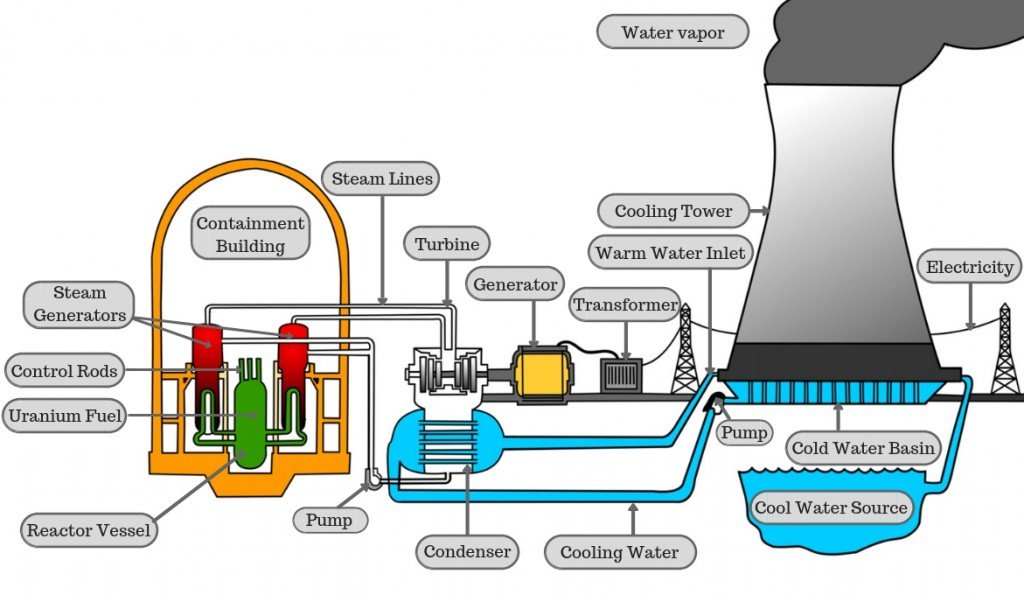Working Principle of Nuclear Power Plant
In a nuclear power plant, nuclear fuel is used such as Uranium U235. The difference between a thermal power plant and nuclear power plant is fuel. Both use their fuel to convert water into steam in Boilers (Steam Generator). This steam is used to run the steam turbine to produce electricity. The thermal power plant uses oil, coal, or gas while nuclear plant uses nuclear fuel.
Nuclear Fuel energy is released by a nuclear Fission Chain reaction in the core of a reactor. 1 kg of Uranium U235 can produce as much energy equal to 3086 tons of coal or 136 m3 of fuel oil. A typical nuclear reaction is shown.
Nuclear Chain Reaction
When the nucleus of an atom of Uranium is split, the two or three neutrons released in this reaction these neutrons hit other atoms and split them in turn. More energy is released each time another atom splits. This phenomenon is called a chain reaction. The nuclear chain reaction can be controlled by control rods and by moderators.
Working in a Nuclear power plant
A Nuclear Power plant is actually like a water-water heat exchanger. Water (Coolant) at High pressure is pumped through the reactor core to get the heat energy from the chain reaction, water is kept at very high pressure to prevent boiling. This high-pressure radioactive water is then circulated through the Steam Generator in the close cycle to transfer its heat to the Boiler feed water in another closed-cycle loop to convert feedwater into steam. using these two loops helps to keep away contaminated water from the other equipment of the plant-like turbine and condenser. Steam is then supplied to the conventional steam turbine generator to produce electricity. From the turbine, the steam is condensed to the liquid phase in a condenser and returned as feedwater to the steam generator.
There are thus two entirely separate closed circulating water loops; the primary (or reactor coolant) loop, which removes heat from the core, and the secondary (or steam-generating) loop, which takes heat from the coolant and conveys it to the turbine. In the above animation, the containment structure is the primary loop.
Main Parts of a Nuclear Power Station
- Containment structure
- Reactor pressure vassal
- Steam generator
- Pressurizer
- Reactor Coolant pump RCP
- Feedwater pump
- Steam turbine
- Control room
Types of nuclear power reactor
- Pressurized water reactor (PWR)
- Boiling water reactor (BWR)
- Heavy water reactor (HWR)
Difference Between PWR and BWR
In Pressurized water reactors, Ordinary water (H2O) used as coolant and moderator. Water is kept at a very high pressure to prevent boiling. The fuel is shaped as cylindrical pellets, filled up in fuel rods, and combined in assemblies. Fuel material is usually UO2 slightly enriched 2 to 4% is used in most pwr power plants. Fuel pellets are stacked in Zircalloy tubes called cladding. Spaces are left in some fuel assemblies for the insertion of control rods. Control rods are in the form of clusters. The reactor core is surrounded by a steel core barrel. The pressure vessel contains light-water which serves as a coolant, moderator, and reflector. Water collects heat from the fuel, gives it up into the steam generator, and is pumped back into the reactor vessel. Modern PWRs have two to four independent steam generator loops in parallel. Water enters the reactor pressure vessel (RPV) at a temperature of about 290 °C, flows down around the outside of the core where it serves as a reflector, then passes through the core where it removes the core’s heat, and finally exits the vessel at a temperature of about 325 °C. The coolant exhausts its heat to the water in the shell side of the steam generator, where it boils and produces steam.










No comments